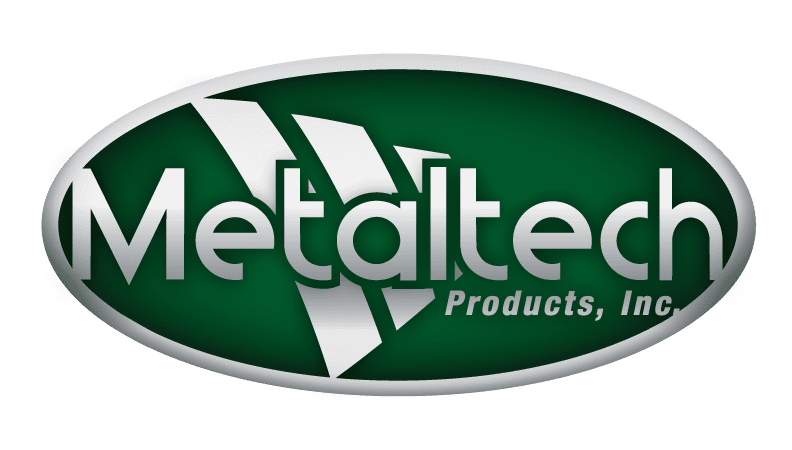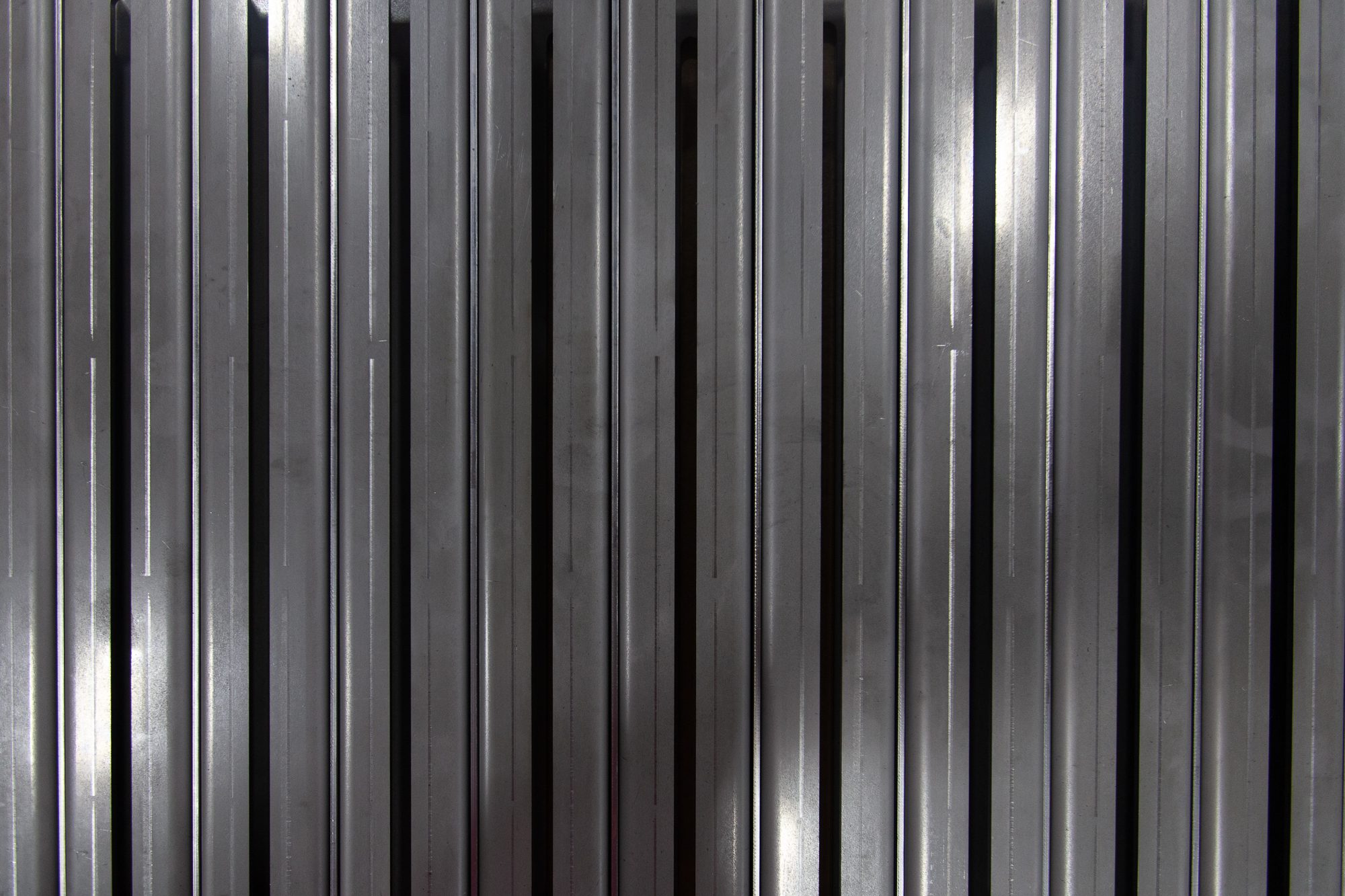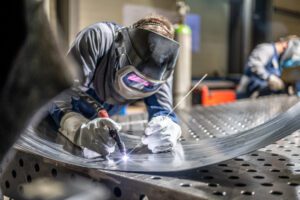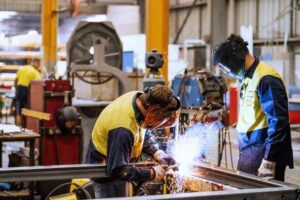The material chosen for a fabrication project affects if it will function as expected. Every metal has properties that determine how it can be processed. Selecting the right metal ensures that component parts can handle their environment and end use. Other factors like finishing processes, the size of the product and the project’s estimated cost may also affect material selection.
What metal would be best for your next project? Read more about the properties of metals and the common types of sheet metals used in fabrication.
Properties of Metals
All metals have unique physical and chemical properties. Some metals are stronger or more naturally resistant to corrosion. Properties of metals include but are not limited to corrosion resistance, malleability, ductility, hardness, tensile strength and weldability.
A metal’s properties affect how you can work with it. That’s why it’s crucial to choose a metal that fits the job. When you work with a metal fabrication company, they help you select a material based on how the material’s characteristics accomplish the product’s end use.
Corrosion Resistance
Metals corrode over time as they’re exposed to oxygen, hydrogen or electrical currents. Exposure to these factors causes refined metal to deteriorate. For example, rust is a common type of corrosion that happens when metals containing iron are exposed to oxygen and water. You can avoid rust and other types of corrosion by treating metal for corrosion resistance.
- Crevice corrosion. Oxygen and water can get trapped under washers or bolt heads, causing corrosion at connected joints.
- Galvanic corrosion. Certain metals react with one another. Corrosion in localized spots occurs when metals exchange ions.
- Uniform corrosion. Large, even areas of corrosion are known as uniform corrosion. This type of corrosion takes place on a metal’s surface.
Stainless steel alloys, aluminum and titanium are very corrosion-resistant. While most steel rusts due to its iron content, stainless steel has a protective alloy ingredient called chromium, which fights against corrosion. Aluminum, on the other hand, is naturally corrosion-resistant since it does not contain iron. Both metals can undergo passivation, a process that forces metal to react and form a protective layer on the surface.
Malleability and Ductility
Metals can be flattened or drawn into wires without breaking. Malleability is the ease at which a metal can be shaped; ductility refers to a metal’s ability to stretch. All metals have layers of ions that roll over one another when force is applied. A metal’s bonds let electrons move freely, which allows metals to be bent and shaped.
Some metals are more malleable or ductile than others. For example, mild steel can easily be rolled into sheets, and copper can easily be drawn into wires.
Hardness
Hardness refers to how metal resists deformation. Soft metals form indentations and can be scratched easily. Hard metals resist change and wear. A metal’s strength, hardness and rigidity are similar, but hardness can help determine if a metal can withstand force.
- Scratch hardness refers to how easy it is to scratch the surface of the metal.
- Rebound hardness looks at how a metal absorbs impact.
- Indentation hardness tests how a metal withstands continuous force.
Tensile Strength
A metal’s tensile strength is the amount of force it can take before it breaks. Stronger metals can withstand higher amounts of tension without breaking. For example, stainless steel can handle high tension but aluminum cannot. There are three factors that make up a metal’s tensile strength:
- Yield strength is the stress a metal can take without permanent damage.
- Ultimate strength is the maximum amount of stress a metal can withstand.
- Breakable strength is the point of stress at which a metal breaks or fails.
Tensile strength helps designers and engineers determine what metal would be most effective for the end product’s function and environment.
Weldability
The weldability of metals is how easily metals can be fused together. Each weld should create a joint that connects the materials, handles tension and doesn’t crack. Some metals require more preparation, specialized tools and advanced expertise to weld, increasing the cost and time of production. These metals may tend to crack, soften, harden or oxidize during the welding process.
The easiest metal to weld is carbon steel, and that’s one of the reasons it is a popular choice for metal fabrication. On the other hand, metals like aluminum are more difficult to weld, requiring a higher degree of skill.
Types of Sheet Metal
Environment, end use and price all factor into choosing a type of sheet metal for your project. At Metaltech Products, we work with the following types of metals:
- Mild steel
- High-strength low-alloy steel (HSLA)
- Stainless steel
- Alumunium
- Copper
- Titanium
Carbon Steel
Carbon steel is one of the most popular metals used in manufacturing. It’s strong and durable due to its higher carbon content. Plus, carbon steel is simple to weld and more affordable than other metals.
Most carbon steel contains up to 2-2.5% carbon. Higher percentages of carbon make the steel stronger. However, the higher the carbon content, the more brittle the steel becomes, making it less ductile and malleable.
Though it’s strong, carbon steel is still susceptible to rust because it contains iron. Carbon steel should be treated or finished with a corrosion-resistant layer.
Types of Steel Sheet Metal
- Mild steel is also known as low-carbon steel. It is tough, ductile and the most common form of carbon steel. Mild steel is often used for automotive parts, channels, angle irons, pipes and construction equipment.
- Medium carbon steel runs right down the line. It has medium hardness, strength and ductility compared to the other types of carbon steel. Medium carbon steel is used to make railway tracks and machinery parts.
- High-carbon steel is the strongest carbon steel out there, but it’s also the least ductile. These steels are often used for cutting tools and die.
- High-strength, low-alloy steels (HSLA) also contain elements like copper and nickel. Because of this, they tend to have higher strengths while keeping their ductility.
Stainless Steel
Stainless steel is both strong and corrosion-resistant. Like carbon steel, stainless steel is easy to work with. However, due to its high chromium content, stainless steel won’t rust like carbon steel. When chromium in stainless steel oxidizes, it creates a protective layer of chromium oxide on the metal’s surface, which protects the metal from rusting and staining.
Three Types of Stainless Steel
- Austenitic stainless steel has a high chromium and nickel content. It’s non-magnetic and the most widely used type of stainless steel.
- Ferritic stainless steel contains 11-30% chromium with little to no nickel. These steels are magnetic and unable to withstand heat treatment.
- Martensitic stainless steel contains no nickel, which makes it corrosion-resistant and hardenable.
Aluminum
Aluminum is light but strong and versatile. It’s often used in aerospace and automotive industries, where high-performance materials are crucial. Aluminum won’t rust because it does not contain iron. It is a naturally corrosion-resistant metal, meaning that it contains a protective alloy ingredient that forms a layer on the surface when it oxidizes. This layer of aluminum oxide protects the metal from corrosion.
Despite its corrosion-resistant powers, aluminum has low ductility and low tensile strength. It also tends to be more expensive than carbon steel.
Copper
As you may have guessed, copper is an excellent conductor of heat and electricity. That’s why it’s often used to manufacture electrical components. In addition to its conductivity, copper is considered a soft metal with very high ductility and malleability.
Like other metals mentioned here, copper also creates a protective layer on its surface when it oxidizes. When exposed to oxygen and water, copper develops a green outer layer, or patina, which protects it from corroding further. Copper’s patina makes the metal an aesthetic or decorative choice for many.
Titanium
Titanium excels in high-stress applications. It’s almost twice as strong as aluminum, yet about 45% lighter than steel. Titanium possesses natural corrosion resistance as well. Combine that with its high melting point, and titanium is an effective material for aerospace components, medical equipment, automotive racing and other industries where weight and corrosion resistance are critical.
Though titanium has many advantages, it is difficult to machine and more expensive than other metals.
If you’re ready to start a production run, Metaltech has the expertise and technology to take your component parts from design to delivery. Our experienced team helps you choose the type of fabrication material best suited for your product’s application.
Request a quote from us today to start your custom metal fabrication project.




